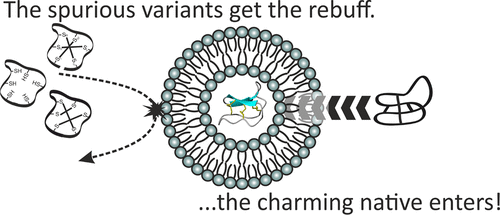当前位置:
X-MOL 学术
›
ACS Chem. Biol.
›
论文详情
Our official English website, www.x-mol.net, welcomes your
feedback! (Note: you will need to create a separate account there.)
Importance of the Cyclic Cystine Knot Structural Motif for Immunosuppressive Effects of Cyclotides
ACS Chemical Biology ( IF 3.5 ) Pub Date : 2021-09-30 , DOI: 10.1021/acschembio.1c00524 Roland Hellinger 1 , Edin Muratspahić 1 , Seema Devi 2 , Johannes Koehbach 3 , Mina Vasileva 1 , Peta J Harvey 3 , David J Craik 3 , Carsten Gründemann 4 , Christian W Gruber 1
ACS Chemical Biology ( IF 3.5 ) Pub Date : 2021-09-30 , DOI: 10.1021/acschembio.1c00524 Roland Hellinger 1 , Edin Muratspahić 1 , Seema Devi 2 , Johannes Koehbach 3 , Mina Vasileva 1 , Peta J Harvey 3 , David J Craik 3 , Carsten Gründemann 4 , Christian W Gruber 1
Affiliation

|
The cyclotide T20K inhibits the proliferation of human immune cells and is currently in clinical trials for multiple sclerosis. Here, we provide novel functional data and mechanistic insights into structure–activity relationships of T20K. Analogs with partial or complete reduction of the cystine knot had loss of function in proliferation experiments. Similarly, an acyclic analog of T20K was inactive in lymphocyte bioassays. The lack of activity of non-native peptide analogs appears to be associated with the ability of cyclotides to interact with and penetrate cell membranes, since cellular uptake studies demonstrated fast fractional transfer only of the native peptide into the cytosol of human immune cells. Therefore, structural differences between cyclic and linear native folded peptides were investigated by NMR to elucidate structure–activity relationships. Acyclic T20K had a less rigid backbone and considerable structural changes in loops 1 and 6 compared to the native cyclic T20K, supporting the idea that the cyclic cystine knot motif is a unique bioactive scaffold. This study provides evidence that this structural motif in cyclotides governs bioactivity, interactions with and transport across biological membranes, and the structural integrity of these peptides. These observations could be useful to understand the structure–activity of other cystine knot proteins due to the structural conservation of the cystine knot motif across evolution and to provide guidance for the design of novel cyclic cysteine-stabilized molecules.
中文翻译:

环状胱氨酸结结构基序对环肽免疫抑制作用的重要性
环肽T20K可抑制人体免疫细胞的增殖,目前正处于治疗多发性硬化症的临床试验中。在这里,我们提供了关于 T20K 结构-活性关系的新颖功能数据和机制见解。部分或完全减少胱氨酸结的类似物在增殖实验中丧失了功能。同样,T20K 的无环类似物在淋巴细胞生物测定中没有活性。非天然肽类似物缺乏活性似乎与环肽与细胞膜相互作用和穿透细胞膜的能力有关,因为细胞摄取研究表明仅天然肽快速部分转移到人免疫细胞的细胞质中。因此,通过核磁共振研究环状和线性天然折叠肽之间的结构差异,以阐明结构-活性关系。与天然环状 T20K 相比,无环 T20K 的主链刚性较低,并且环 1 和 6 发生了相当大的结构变化,这支持了环状胱氨酸结基序是独特的生物活性支架的观点。这项研究提供的证据表明,环肽中的这种结构基序控制着生物活性、与生物膜的相互作用和跨生物膜的运输,以及这些肽的结构完整性。由于胱氨酸结基序在进化过程中的结构保守性,这些观察结果可能有助于理解其他胱氨酸结蛋白的结构活性,并为新型环状半胱氨酸稳定分子的设计提供指导。
更新日期:2021-11-19
中文翻译:

环状胱氨酸结结构基序对环肽免疫抑制作用的重要性
环肽T20K可抑制人体免疫细胞的增殖,目前正处于治疗多发性硬化症的临床试验中。在这里,我们提供了关于 T20K 结构-活性关系的新颖功能数据和机制见解。部分或完全减少胱氨酸结的类似物在增殖实验中丧失了功能。同样,T20K 的无环类似物在淋巴细胞生物测定中没有活性。非天然肽类似物缺乏活性似乎与环肽与细胞膜相互作用和穿透细胞膜的能力有关,因为细胞摄取研究表明仅天然肽快速部分转移到人免疫细胞的细胞质中。因此,通过核磁共振研究环状和线性天然折叠肽之间的结构差异,以阐明结构-活性关系。与天然环状 T20K 相比,无环 T20K 的主链刚性较低,并且环 1 和 6 发生了相当大的结构变化,这支持了环状胱氨酸结基序是独特的生物活性支架的观点。这项研究提供的证据表明,环肽中的这种结构基序控制着生物活性、与生物膜的相互作用和跨生物膜的运输,以及这些肽的结构完整性。由于胱氨酸结基序在进化过程中的结构保守性,这些观察结果可能有助于理解其他胱氨酸结蛋白的结构活性,并为新型环状半胱氨酸稳定分子的设计提供指导。











































 京公网安备 11010802027423号
京公网安备 11010802027423号